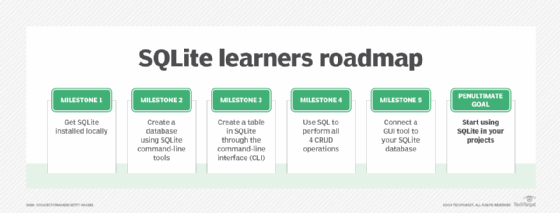SQLite tutorial for beginners
SQLite has an incredibly small footprint.
The database itself, its DLLs and the complimentary diff and analyzer tools are less than 15 MB in size. It's perfect for small mobile devices, advanced robotic engines and microservices alike. There's no wonder why SQLite is the most used database engine in the world.
SQLite learning roadmap
If you've never used it before, this SQLite tutorial not only gets you started, it also gives you the foundational skills to build your own apps in this fast, self-contained and highly reliable database.
The key topics covered include the following:
- How to find out if SQLite is preinstalled on your device.
- How to install SQLite, specifically on a Windows machine.
- How to create an SQLite database at the command line.
- How to perform standard CRUD operations through the SQLite CLI.
- How to use an SQLite viewer, specifically the DB Browser for SQLite3.

Beyond the SQLite3 basics
Once you're able to create databases; configure tables and data types; issue SQL statements; and attach various database viewer tools to your SQLite3 instance, where you take your newfound database skills is up to you.
Java developers will want to explore how to configure an SQLite JDBC driver and programmatically connect. Because SQLite is written in C, systems programmers will want to look at native operability. And both JavaScript and Python integration with SQLite is both standardized and commonplace.
Whether you simply want to learn the ins and outs of database connectivity, or you plan to integrate SQLite into your next database-driven microservice, this SQLite tutorial is the perfect place to start your learning journey.
Cameron McKenzie has been a Java EE software engineer for 20 years. His current specialties include Agile development; DevOps; Spring; and container-based technologies such as Docker, Swarm and Kubernetes.


